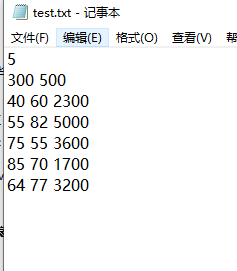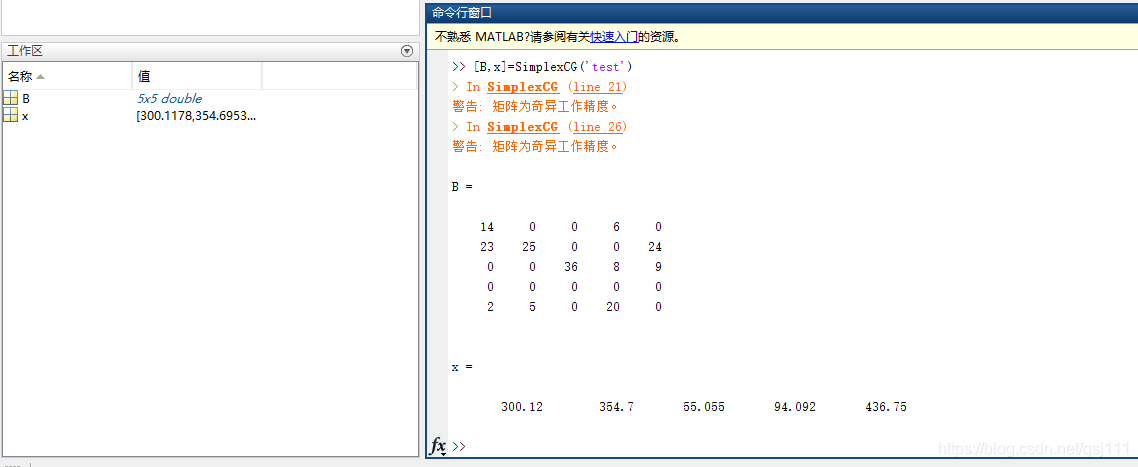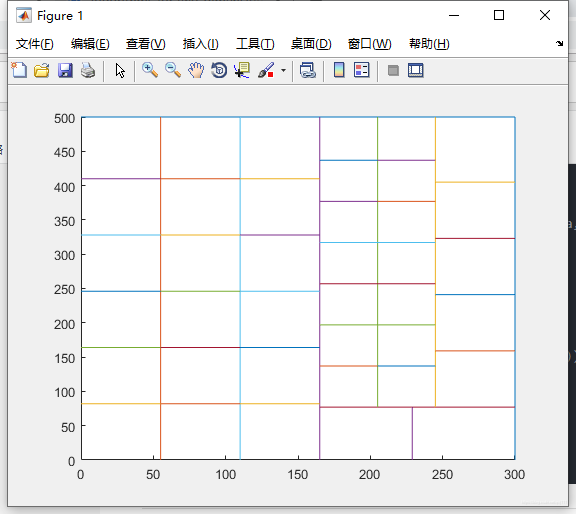深切哀悼抗击新冠肺炎疫情斗争牺牲烈士和逝世同胞
这学期接了《运筹学》课程,在国内抗疫的大环境下,勉勉强强当了七周主播,刚刚讲完对偶理论。
这里必须要吐槽一下《线性代数》的老师,本科生的课程不要放水好不好?讲单纯形法足足用了三周课,每堂课都要给学生科普或者强化线代基础。
为了强化学生对对偶理论的理解,计划在接下来三周课程里介绍大规模问题的优化方法,Dantzig-Wolfe分解,Benders分解和ADMM(Alternating direction method of multipliers)。
(想想后面还要讲整数规划、动态规划、网络规划、非线性规划、排队论、……,头都大。)
说到Dantzig-Wolfe分解,不得不提的就是列生成算法,最早用来解决一维下料问题(cutting stock problem)。但一维下料问题似乎太乏味了,怕学生们提不起兴趣,这里就找了一篇解决矩形下料问题的文章,复现了一下。
Cintra G F , Miyazawa F K , Wakabayashi Y , et al. Algorithms for two-dimensional cutting stock and strip packing problems using dynamic programming and column generation[J]. European Journal of Operational Research, 2008, 191(1):61-85.
https://doi.org/10.1016/j.ejor.2007.08.007
同行们一定都很熟悉这篇文章,很好的解决了gcut中13个算例,并且提出了变尺寸母板的解决策略。
这里只实现了最基本的几段代码。
Matlab代码
// 生成离散点集
function P=DPP(D,d)
P=0;
m = length(d);
for j=0:D
c(j+1)=0;
end
for i=1:m
for j=d(i):D
if c(j+1)<c(j-d(i)+1)+d(i)
c(j+1)=c(j-d(i)+1)+d(i);
end
end
end
mind = min(d);
for j=1:D-mind
if c(j+1)==j
P=[P,j];
end
end
P=[P,D];
// 矩形背包问题算法
// 为方便回溯方案,将item修改为三维整数矩阵,前两维对应状态空间,第三维为该状态空间最大价值时满足各订单的数量
// guillotine 改为整数二维数组,其中0 ———— 不切;1 ———— 对w方向切割;2 ———— 对h方向切割
function [z,V,item,guillotine,position]=DP(W,H,w,h,v)
m=length(w);
P=DPP(W,w);
Q=DPP(H,h);
r=length(P);
s=length(Q);
V=zeros(r,s);
item=zeros(r,s,m);
guillotine=zeros(r,s);
position=zeros(r,s);
for i=1:r
for j=1:s
[V(i,j),item(i,j,:)]=inital_dp(w,h,v,P,Q,i,j); //调用第三段程序初始化状态空间
guillotine(i,j)=0;
end
end
for i=2:r
for j=2:s
[~,n]=max(P(P<=floor(P(i)/2)));
for x=1:n
[~,t]=max(P(P<=(P(i)-P(x))));
if V(i,j)<V(x,j)+V(t,j)
V(i,j)=V(x,j)+V(t,j);
item(i,j,:)=item(x,j,:)+item(t,j,:);
position(i,j)=P(x);
guillotine(i,j)=1; %w方向切割
end
end
[~,n]=max(Q(Q<=floor(Q(j)/2)));
for y=1:n
[~,t]=max(Q(Q<=(Q(j)-Q(y))));
if V(i,j)<V(i,y)+V(i,t)
V(i,j)=V(i,y)+V(i,t);
item(i,j,:)=item(i,y,:)+item(i,t,:);
position(i,j)=Q(y);
guillotine(i,j)=2; %h方向切割
end
end
end
end
z=zeros(m,1);
for i=1:m
z(i)=item(r,s,i);
end
// 初始化每个状态空间的最大价值
function [V,maxk]=inital_dp(w,h,v,P,Q,i,j)
V=0;
m=length(v);
maxk=zeros(1,m);
for k=1:m
if w(k)>P(i)
continue;
end
if h(k)>Q(j)
continue;
end
if v(k)>V
V=v(k);
maxk=zeros(1,m);
maxk(k)=1;
end
end
//列生成算法主程序
//修正了一处论文中的伪代码错误 Bw = z
//用"\","/"替代 *inv()
//绘图时用 cut(i).w cut(i).h 存储第i个待画任务对应状态空间的横纵编号 cut.x cut.y 存储其起始位置(左下坐标值)
//方案结果呈现(绘图)的回溯算法暂时没想到更好的方法,欢迎大家提供宝贵意见!
function [B,ans]=SimplexCG(filename)
file = [.\gcut\',filename,'.txt']; //算例存放在下级gcut文件夹中
data = textread(file);
m=data(1,1);
W=data(2,1);
H=data(2,2);
w=data(3:2+m,1)';
h=data(3:2+m,2)';
d=data(3:2+m,3)';
x=d;
B=eye(m);
P=DPP(W,w);
Q=DPP(H,h);
r=length(P);
s=length(Q);
m_V=zeros(m,r,s);
m_item=zeros(m,r,s,m);
m_guil=zeros(m,r,s);
m_pos=zeros(m,r,s);
while(true)
y=ones(1,m)/B;
[z,V,item,guillotine,position]=DP(W,H,w,h,y);
if y*z<=1
break;
end
omega=z'/B;
t=1e6;
s=-1;
for j=1:m
if omega(j)<=0
continue;
end
if t>(x(j)/omega(j))
t=x(j)/omega(j);
s=j;
end
end
if s==-1
break;
end
m_V(s,:,:)=V;
m_item(s,:,:,:)=item;
m_guil(s,:,:)=guillotine;
m_pos(s,:,:)=position;
for i=1:m
B(i,s)=z(i);
if i==s
x(i)=t;
else
x(i)=x(i)-omega(i)*t;
end
end
end
ans = x;
P=DPP(W,w);
Q=DPP(H,h);
r=length(P);
s=length(Q);
//画出最后方案
for i=1:m
figure(i);
hold on
plot([0,W,W],[H,H,0])
cut(1).w=r;
cut(1).h=s;
cut(1).x=0;
cut(1).y=0;
while(~isempty(cut))
a=cut(1).w;
b=cut(1).h;
x=cut(1).x;
y=cut(1).y;
cut(1)=[];
num=length(cut);
if m_guil(i,a,b)==0
continue;
end
if m_guil(i,a,b)==1
plot([x+m_pos(i,a,b),x+m_pos(i,a,b)],[y,y+Q(b)]);
[~,cut(num+1).w]=max(P(P<=m_pos(i,a,b)));
cut(num+1).h=b;
cut(num+1).x=x;
cut(num+1).y=y;
[~,cut(num+2).w]=max(P(P<=P(a)-m_pos(i,a,b)));
cut(num+2).h=b;
cut(num+2).x=x+m_pos(i,a,b);
cut(num+2).y=y;
end
if m_guil(i,a,b)==2
plot([x,x+P(a)],[y+m_pos(i,a,b),y+m_pos(i,a,b)]);
cut(num+1).w=a;
[~,cut(num+1).h]=max(Q(Q<=m_pos(i,a,b)));
cut(num+1).x=x;
cut(num+1).y=y;
cut(num+2).w=a;
[~,cut(num+2).h]=max(Q(Q<=Q(b)-m_pos(i,a,b)));
cut(num+2).x=x;
cut(num+2).y=y+m_pos(i,a,b);
end
end
end
算例文件

格式参考gcut设置,具体如下:
- 第一行数据 ‘5’ 表示订单种类数;
- 第二行数据’300 500’表示母板规格(宽300 x 长500);
- 第三行起为订单数据 ‘40 60 2300’ 表示 宽40长60的订单需求为2300件。
运行结果

- B为算法结束时基矩阵;
- x为最优解,每列方案使用次数。
最优解方案展示





推荐大家关注公众号数据魔术师。
